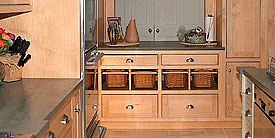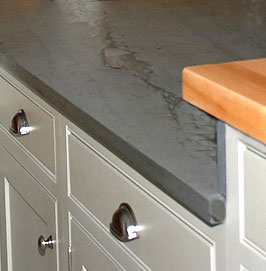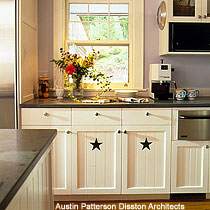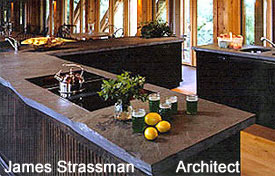 Slate is the quiet, little known, but serious, player in countertops for kitchens! Of course, slate is traditionally seen as a building material for flooring, roofing, cladding on buildings, wherever there is a need for a very strong, solidly performing material. So, why not kitchen countertops? I'll warn you in advance...mention slate to people in the biz, including countertop fabricators, and most likely you'll get, "No way, slate will stain and is too porous!" It could be followed by "You're nuts!" While I've been accused of being nuts on numerous occasions, it doesn't apply to this situation. Trust me...
Slate is the quiet, little known, but serious, player in countertops for kitchens! Of course, slate is traditionally seen as a building material for flooring, roofing, cladding on buildings, wherever there is a need for a very strong, solidly performing material. So, why not kitchen countertops? I'll warn you in advance...mention slate to people in the biz, including countertop fabricators, and most likely you'll get, "No way, slate will stain and is too porous!" It could be followed by "You're nuts!" While I've been accused of being nuts on numerous occasions, it doesn't apply to this situation. Trust me...
Rarely marketed to kitchen and bath designers for some reason, slate is, perhaps, one of the strongest, if not the strongest, materials one can use as a kitchen countertop, even exceeding the properties of granite. Slate, as a countertop material, has numerous properties that we need in a hard working countertop surface. And, by the by, I'm VERY conservative in terms of recommending countertop surfaces to my clients. Countertops are expensive, permanent, materials, not to be taken lightly by a specifier. I don't. Slate works!
Color
Slate is available in a variety of colors. Mostly understated, in middle to dark tones, the colors of slate are generally seen as:
- Red
- Deep Purple
- Deep Purple/Turquoise Combination
- Turquoise
- Gray
- Black
The look is quiet, elegant, strong, simplistic, nature-like, minimalist, dependent on its application within the room. Slate is almost always honed, although it can be oiled for a slightly more glossy look.
Pattern/Graining Depending on the variety of the slate, the grain type and pattern can vary. Some slates, as Black Lace, has a distinctive highly textural, high-style look. Other slates exhibit very little graining whatsoever. Others are mottled. Some are quiet, with little graining, except for one strong, localized grain pattern, running through the slate, for a look of pure, natural beauty! Graining pattern/direction/type cannot be predicted. Unless you want to schlep to the factory in New England, pick out your own slabs and tell them where to cut and where not to cut. Short of that, pictures of existing installations should prove to be a good guide.
Depending on the variety of the slate, the grain type and pattern can vary. Some slates, as Black Lace, has a distinctive highly textural, high-style look. Other slates exhibit very little graining whatsoever. Others are mottled. Some are quiet, with little graining, except for one strong, localized grain pattern, running through the slate, for a look of pure, natural beauty! Graining pattern/direction/type cannot be predicted. Unless you want to schlep to the factory in New England, pick out your own slabs and tell them where to cut and where not to cut. Short of that, pictures of existing installations should prove to be a good guide.
Edging
Typically, slate edges are simple square edges with a very small radius top and bottom. Variations could be any edge one would see in granite. Due to the understated look, slate is not often seen with an ogee (OG) edge. Slate is perfect for a rough cut, exposed, edge. Perfect for today's uber-rustic-eco aesthetics.
Properties One of the best properties of slate is its extremely low absorption rate, lower than granite. Designers can consider most slates as being stain-free. I have performed testing on the turquoise/green colors and have found these slate colors to be stain-free. Slate in the gray/black family may need a sealer. As a result of slate's low absorption, the material can be considered anti bacterial in nature and totally eco friendly.
One of the best properties of slate is its extremely low absorption rate, lower than granite. Designers can consider most slates as being stain-free. I have performed testing on the turquoise/green colors and have found these slate colors to be stain-free. Slate in the gray/black family may need a sealer. As a result of slate's low absorption, the material can be considered anti bacterial in nature and totally eco friendly.
Some slates (and partially-metamorphosed “mudstones” which are incorrectly called slates) are significantly weaker, than the slates I am talking about and are more absorptive, softer and prone to delamination and “self-splitting”. The slates that are good for countertops are found in the New England region.
Slab material generally is available in smaller sizes than granite, resulting in an additional seam or two. You should pay attention to seaming issues. Have your designer take a close look at how best to put the pieces together according to your cabinet plan.
Care
 Soap and water, or even a tough cleaning product such as Fantastic can be used. If a sheen is desired, use a diluted solution of Murphy's Oil Soap and water. Apply, and buff off before it dries.
Soap and water, or even a tough cleaning product such as Fantastic can be used. If a sheen is desired, use a diluted solution of Murphy's Oil Soap and water. Apply, and buff off before it dries.
Scratches are easily removed, simply, with a sponge, during normal cleaning of the countertop. Deeper scratches are easily rubbed out with wet steel wool. Small white scratches are fairly typical to see during use over time, but are easily wiped clean during the day, if you see them at all.
Really only the gray and black stones need to be sealed as they are more absorptive in nature than other colored slates. Thus, mild soaps only should be used on these colors, so as not to strip the sealer. I usually get samples and then do a whole "food stuffs" test over a 24 hour period, beat it up in other ways and then evaluate.
I really love slate. It's eco friendly, it feels like butter to the touch, it's understated and fits many design aesthetics. I can't wait till I use it again for a project. Never had a client complain once installed, and I've installed quite a few slate countertops, only raves. And, THAT'S the test!

